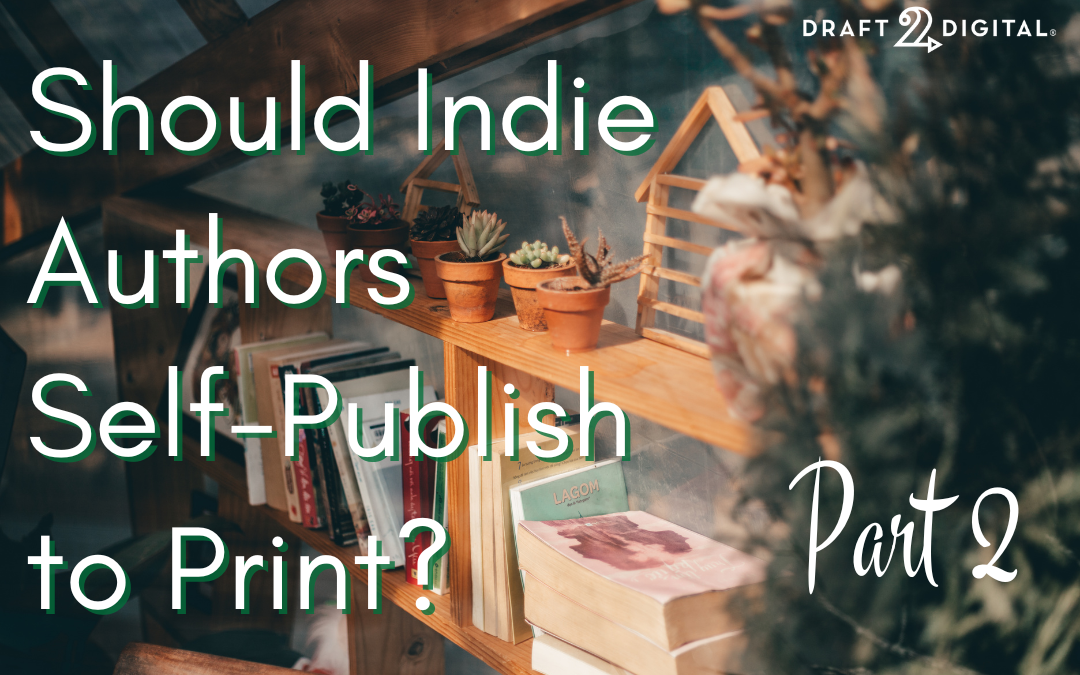In Part 1 of this series, we talked about some of the myths surrounding publishing to print for indie authors and debunked a fair few around sales and cost. TL;DR: print books sell better than ebooks and they’re nearly free to produce on D2D Print.
In Part 2, we’ll dig into the numerous benefits of publishing to print that aren’t just for traditionally published authors anymore.
The benefits of publishing to print
On top of the fact that some traditional drawbacks (like investing in a big print run) simply aren’t required anymore, self-published authors who are serious about marketing their books will find a lot to love about releasing in print. Besides, let’s face it—holding a copy of your book in your hands is just fun!
Attract reviewers
Reviews are a critical component of any author’s marketing campaign, whether they be on Amazon, Goodreads, BookTok, book blogs, newspapers, or virtually anywhere else. Many of these reviewers insist on receiving hard copies, because they want to have something to show their viewers if they’re on video. Also, the last thing anyone wants to do after a long day online is to stare at another screen. Print makes it easier to get a “yes” when asking reviewers to check out your book.
Keep reader focus
Even basic e-reading devices are rife with distractions whenever they’re connected to the internet. In some cases, notifications that would normally end up on your phone might even find their way to your tablet or e-reader while you’re trying to focus. Publishing to print enables your readers to focus solely on your book and nothing else—a feat akin to keeping visitors on your website. The longer you keep your readers’ attention, the more likely they’ll be hooked!
Free marketing
How many times have you seen someone staring at an e-reader and been able to strike up a conversation about the book they’re reading? Probably zero. An e-reader looks the same no matter what book someone is reading. This makes it a handy device for readers of steamy romance looking to digest NSFW content on the train, but eliminates the opportunity for your readers to do a bit of free advertising for you. With a printed copy of your book in their hands, family, friends, and fellow commuters can ask your readers about the book they’re holding—and hopefully, buy a copy after hearing their glowing recommendation.
Long lifespan
Most people won’t throw away a print book. Whether they read it right away or not, it will likely sit on their shelf or bedside table for a while, where others will see it. If the original purchaser moves or doesn’t need it anymore, they’ll gift it to someone or donate it. Either way, you’ve just gained an easy and effective way to reach new readers without lifting a finger. Digital books don’t have this kind of longevity. If the original buyer doesn’t read them or talk about them, they just sit forgotten on that reader’s device.
Make it easy for readers to find you
One of the main arguments for publishing wide is to make it as easy as possible for readers to find you in whatever format they prefer. This means getting into readers’ hands wherever they consume written content. Some readers simply prefer paper and won’t pick up a book unless print is an option. According to WordsRated, 37% of Americans claim to only read print books, and print is even more popular still in Europe.
Build an authorial image
Publishing your book in print is a bit like putting your best foot forward with a high-quality blurb, cover design, and edit. Publishing to print helps demonstrate to readers that you believe in your work enough to fully invest in it. (Not that POD requires any up-front investment with D2D Print—but your readers won’t know that!) Anyone can self-publish in a digital format, but it takes just enough extra legwork to get your book in print to help set you apart. Rightly or wrongly, print editions offer additional proof of “legitimacy” in the eyes of many readers.
Hold book signings and other events
You can’t hold a book signing without a physical book to sign! While release parties and book launches don’t require the physical presence of a book, offering print copies at any event does help bolster attention. Certain programs like Goodreads Giveaways even require physical editions of your book to participate. If you so choose, you can order a batch of copies and hand-sell them at conventions, flea markets, local fairs, etc. Print enables you to partner with local organizations for promotional campaigns that involve shipping physical items or offering signed copies to attract readers.
Rise above the noise
On top of everything else, the amount of digital noise and the prevalence of quick-made content is all the more reason to put some focus on print. It’s already tough enough for indie authors to stand out, and even tougher if they’re only competing digitally. Amazon releases over 1.4 million self-published ebooks through KDP alone every year—and that’s just for authors exclusive to a single platform. Helping readers find your book is the key to marketing, and print helps you rise above some of the noise and bustle of digital formats.
Other marketing opportunities
If you’re a non-fiction author and speaker, organizations will often pay you to speak and buy a copy of your book for everyone in the audience on top of that. They might even offer some signed books as an incentive for the audience to arrive early or buy a copy on-site. Finally, who doesn’t want to see their work on the shelf of their local bookstore? Your local bookseller can’t carry copies of your ebook on their shelves.
If you’re ready to publish to print, just log in to your Draft2Digital account to get started! We’ll help you go from text doc to POD-ready in just a few minutes.
